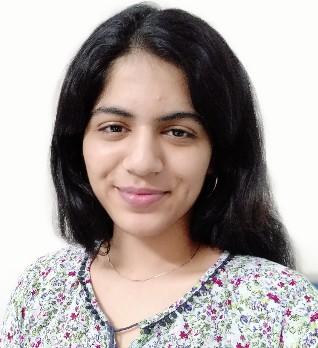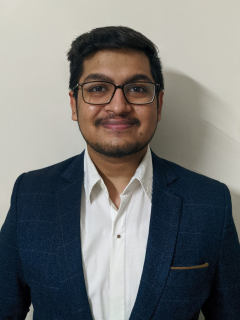People are the future of software. That’s why IRIS-HEP takes pride in mentoring young researchers and giving them the tools they need to thrive within high energy physics and computer science. Through the IRIS-HEP fellowship program, undergraduate students at accredited institutions are given a stipend to spend a few months working on a project and developing their programming skills.
Below are some recent IRIS-HEP fellows on what they learned during their time with the software collaboration, what they’re up to now, and why they’d recommend the IRIS-HEP fellowship to other up and coming researchers in the field.
Garima Singh

Garima Singh Photo credit: Garima Singh
Garima Singh first got involved with IRIS-HEP in January of 2021 while pursuing a bachelor’s in information technology from the Manipal Institute of Technology in India. In high school, Singh took a computer science class which launched her interest in pursuing the subject as a career.
As a fellow, Singh worked on developing a tool for estimating floating point errors. Because computers represent numbers using sets of bits, the real value of numbers cannot be represented with complete accuracy. In the course of doing many operations, errors in this “floating point” accuracy accumulate. This project caught Singh’s eye because during undergrad she had been trying to write a machine learning model in the coding language C++ and realized all her results were coming out incorrect due to floating point errors. She said she applied to the project at IRIS-HEP to see if she could help users find these errors and fix them.
Now, Singh works as a research software developer intern with CERN. In the fall, she’ll be attending ETH Zurich in Switzerland to pursue her master’s in computer science. “My fellowship with IRIS-HEP made me grow a lot academically,” Singh said. “It inspired me to actually apply for grad school and made me realize this is something I really want to do long-term.”
“Garima’s communication and engineering skills were instrumental in shaping several development directions of tools such as RooFit and ROOT,” says Vassil Vassilev, a research software engineer working with Princeton University who acted as Singh’s mentor during her fellowship. “I was happy to see her talent was recognized elsewhere and now she is admitted in ETH Zurich to further develop her potential in one of the top institutions worldwide in the field of computer science.”
To prospective fellows, Singh advises that you’ll learn a lot. “The fellowship is very technically rewarding but it is also rewarding in a more holistic sense,” she said. “You get to learn a lot about how research is actually done.”
Elliott Kauffman

Elliott Kauffman Photo credit: Elliott Kauffman
Elliott Kauffman joined IRIS-HEP as a fellow in May of 2022 between his junior and senior year as an undergraduate in physics at Duke University. Kauffman said he was inspired to pursue particle physics after watching a documentary about the discovery of the Higgs boson when he was in middle school.
Since 2022, Kauffman has worked on two projects with IRIS-HEP. For his fellowship, he was involved in a project where he used machine learning to reconstruct primary vertices — the point where protons collide after moving through the Large Hadron Collider (LHC). More recently, Kauffman worked on the Analysis Grand Challenge. This software grand challenge aims to integrate different projects within IRIS-HEP into a realistic analysis workflow, demonstrating and exploring how such a pipeline will function under the increased volume of data anticipated in the upcoming high luminosity upgrade of the LHC.
“As someone who comes from a primarily physics background, I did not study computer science directly,” said Kauffman. “IRIS-HEP allowed me to catch up in that respect, because it’s important for an experimental physicist to also be well-versed in computing.”
In the fall, Kauffman will begin working toward his doctorate at Princeton University. While his time with IRIS-HEP will officially come to a close in the summer, he said he plans to continue to be involved with the collaboration at some point in the future. During his time as a fellow, Kauffman worked with mentor Rocky Bala Garg, a postdoctoral researcher at Stanford University. “Elliott has consistently demonstrated remarkable focus, diligence and organizational skills,” said Bala Garg of her time working with Kauffman. “He possesses a remarkable ability to swiftly identify and implement solutions to various problems.”
Kauffman said he’d “definitely” recommend other young physicists apply for a fellowship with the software collaboration. “IRIS-HEP is a very welcoming and inclusive community,” he said. “It’s refreshing to see a community where I feel welcomed and accepted.”
Aman Goel

Aman Goel Photo credit: Aman Goel
Aman Goel completed two fellowships with IRIS-HEP, the first starting in June of 2021 and the second in February of 2022. At the time, he was pursuing a bachelor’s in information technology and mathematics from the University of Delhi. “IRIS-HEP introduced me to the field of research software engineering, which became my ultimate career goal,” Goel said.
For his first project with the software collaboration, Goel developed “stacked” histograms which provided a new way for developers to work with data within the collaboration’s histogram library. When he took on his second fellowship, Goel took on the additional project of creating an initial version of an interface which allows for researchers to browse ROOT files from the terminal.
Currently, Goel works as a research software engineer with the University of Manchester in England. Not only did his time as an IRIS-HEP fellow prepare him for the ins and outs of software engineering as a field, Goel said his fellowship helped expose him to the community at large. “Being able to present at conferences was a good way to meet a lot of people in high energy physics and research software engineering,” he said.
“The most unique thing about Aman was how enthusiastically he went beyond code by getting involved with teaching, outreach, and service,” said Henry Schreiner, a computational physicist with Princeton University who mentored Goel throughout his fellowship. “He worked with the High Energy Physics Software foundation on moderating training sessions and assisted with materials and actively responded to users on issues and in forums.”
The fellowship opportunity with IRIS-HEP is one that Goel said he’d recommend to everyone. “IRIS-HEP provides a good base for people to enter the research software space,” said Goel. “Another major positive is how supportive everyone in the collaboration is.”
Rohith Karur

Rohith Karur Photo credit: Rohith Karur
Rohith Karur became a fellow for IRIS-HEP in June 2021, during his time as an undergraduate at the University of California, Berkeley. His professor Heather Gray, the Innovative Algorithms Area co-Lead for IRIS-HEP, recommended he apply for the role. “The fellowship represents a computer science and physics crossover,” said Karur. “So it seemed to be very aligned with things that I was interested in.”
One of the most important parts of particle physics is reconstructing the tracks particles take during experiments in colliders. “I was essentially using the Spotify algorithm for song recommendations to track particles,” said Karur of the project he took on during the course of his fellowship. The music streaming app Spotify uses a variant of what is called a hashing algorithm to group songs and albums of similar genres together. Based on a user’s listening patterns, the algorithm can then recommend other similar songs they may like. “It turns out that the algorithm that computes this is very suited to tracking particles,” said Karur.
After completing his fellowship and graduating with a bachelor’s in physics, Karur is now pursuing a Ph.D. in physics from Berkeley. However, he’s switched his interest from particle physics to nuclear theory. Although Karur said his interests have changed, the need to complete heavy computational work has followed him from his time with IRIS-HEP to now.
“I was very impressed with Rohith’s capabilities and his work ethic,” said Louis-Guillaume Gagnon, a postdoctoral researcher at UC Berkeley who worked as Karur’s mentor throughout his fellowship. “I have rarely encountered an undergrad student at such a skill level.”
Ultimately, Karur said the fellowship is a good opportunity for students who are still choosing which of the variety of the routes one can take in the physics field to pursue. “This fellowship is really aimed towards somebody who’s equally interested in computation and physics,” Karur said. “It’s really good for somebody who hasn’t made up their mind on what they want to do yet.”
